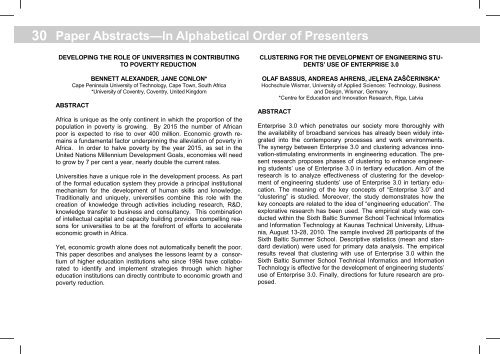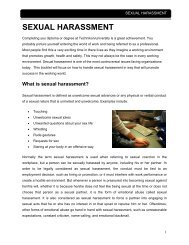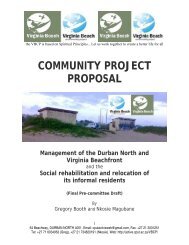Conference Booklet 11 Nov - Nina - CPUT ACTIVE Web - Cape ...
Conference Booklet 11 Nov - Nina - CPUT ACTIVE Web - Cape ...
Conference Booklet 11 Nov - Nina - CPUT ACTIVE Web - Cape ...
Create successful ePaper yourself
Turn your PDF publications into a flip-book with our unique Google optimized e-Paper software.
30<br />
Paper Abstracts—In Alphabetical Order of Presenters<br />
DEVELOPING THE ROLE OF UNIVERSITIES IN CONTRIBUTING<br />
TO POVERTY REDUCTION<br />
BENNETT ALEXANDER, JANE CONLON*<br />
<strong>Cape</strong> Peninsula University of Technology, <strong>Cape</strong> Town, South Africa<br />
*University of Coventry, Coventry, United Kingdom<br />
ABSTRACT<br />
Africa is unique as the only continent in which the proportion of the<br />
population in poverty is growing. By 2015 the number of African<br />
poor is expected to rise to over 400 million. Economic growth remains<br />
a fundamental factor underpinning the alleviation of poverty in<br />
Africa. In order to halve poverty by the year 2015, as set in the<br />
United Nations Millennium Development Goals, economies will need<br />
to grow by 7 per cent a year, nearly double the current rates.<br />
Universities have a unique role in the development process. As part<br />
of the formal education system they provide a principal institutional<br />
mechanism for the development of human skills and knowledge.<br />
Traditionally and uniquely, universities combine this role with the<br />
creation of knowledge through activities including research, R&D,<br />
knowledge transfer to business and consultancy. This combination<br />
of intellectual capital and capacity building provides compelling reasons<br />
for universities to be at the forefront of efforts to accelerate<br />
economic growth in Africa.<br />
Yet, economic growth alone does not automatically benefit the poor.<br />
This paper describes and analyses the lessons learnt by a consortium<br />
of higher education institutions who since 1994 have collaborated<br />
to identify and implement strategies through which higher<br />
education institutions can directly contribute to economic growth and<br />
poverty reduction.<br />
CLUSTERING FOR THE DEVELOPMENT OF ENGINEERING STU-<br />
DENTS’ USE OF ENTERPRISE 3.0<br />
OLAF BASSUS, ANDREAS AHRENS, JEĻENA ZAŠČERINSKA*<br />
Hochschule Wismar, University of Applied Sciences: Technology, Business<br />
and Design, Wismar, Germany<br />
*Centre for Education and Innovation Research, Riga, Latvia<br />
ABSTRACT<br />
Enterprise 3.0 which penetrates our society more thoroughly with<br />
the availability of broadband services has already been widely integrated<br />
into the contemporary processes and work environments.<br />
The synergy between Enterprise 3.0 and clustering advances innovation-stimulating<br />
environments in engineering education. The present<br />
research proposes phases of clustering to enhance engineering<br />
students’ use of Enterprise 3.0 in tertiary education. Aim of the<br />
research is to analyze effectiveness of clustering for the development<br />
of engineering students’ use of Enterprise 3.0 in tertiary education.<br />
The meaning of the key concepts of “Enterprise 3.0” and<br />
“clustering” is studied. Moreover, the study demonstrates how the<br />
key concepts are related to the idea of “engineering education”. The<br />
explorative research has been used. The empirical study was conducted<br />
within the Sixth Baltic Summer School Technical Informatics<br />
and Information Technology at Kaunas Technical University, Lithuania,<br />
August 13-28, 2010. The sample involved 28 participants of the<br />
Sixth Baltic Summer School. Descriptive statistics (mean and standard<br />
deviation) were used for primary data analysis. The empirical<br />
results reveal that clustering with use of Enterprise 3.0 within the<br />
Sixth Baltic Summer School Technical Informatics and Information<br />
Technology is effective for the development of engineering students’<br />
use of Enterprise 3.0. Finally, directions for future research are proposed.





